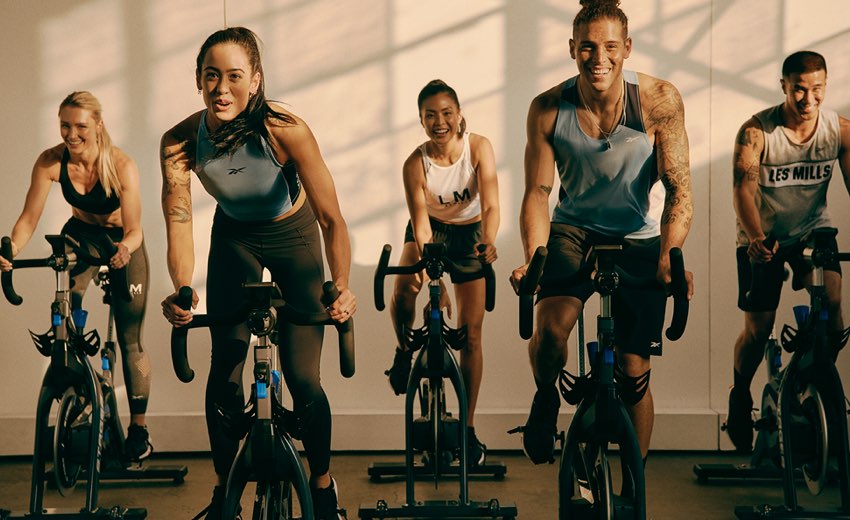
“The night is darkest just before dawn.” So says the old adage often heard in Hollywood movies when the going gets tough.
And while the science behind it might not stand up to scrutiny, the sentiment certainly rings true when applied to the fitness industry as we head into 2021.
After what was undoubtedly the worst year clubs have ever faced, the COVID second wave and a spate of fresh lockdowns have left markets around the world decidedly low on New Year cheer.
But despite the current gloom, there is plenty of light at the end of the tunnel. With COVID vaccines now in sight and the fitness industry having finally undergone the digital transformation we’ve spent much of the past decade talking about, 2021 has the potential to be a decisive year for operators. Here are eight reasons for clubs to be cheerful about the 12 months ahead.
1. Health is the new wealth
Despite being in the midst of a global recession, several reports have indicated that the majority of people intend to spend more on their fitness as a result of the pandemic, or maintain current levels of spending.
The recent Post Lockdown Recovery Report from Leisure-net found that 90% of consumers intend to spend the same amount of money or more on being active as they come out of lockdown. This chimes with a post-lockdown Nielsen survey from China, that found 75% of the public planning to spend more on sport and fitness in the future, while 80% are trying to eat more healthily.
With health becoming everyone’s top priority, there will be significant growth opportunities for clubs as they emerge from the pandemic and return to full capacity. The data suggests that once COVID-19 anxiety subsides, many of the new fitness fans that clubs have won online will be eager to ditch isolation and embrace the thrill of live fitness experiences. Early signs from markets that have made a full COVID recovery – such as China and New Zealand – indicate many clubs are already seeing a jump in new members as more people embark on exercise regimes.
2. Most members still love their club
Despite media proclamations that the COVID-inspired home fitness boom would spell the end of fitness facilities, the most encouraging insight is that the majority of members can’t wait to get back to their club.
Operators in China, Japan, New Zealand and the UAE have reported reaching upwards of 95 percent of pre-COVID attendance levels in recent months. Meanwhile, a recent ClubIntel report – which surveyed 2,000 club members from across the US – found the majority of operators can expect their post-COVID membership levels to range from 65% to 84%, in the early months after reopening, with a range of 75% to 80% most likely.
In Europe, nine in 10 members intend to return to the UK's gyms and leisure centers, according to The COVID-19 Impact Report from ukactive and 4global. Using modeling based on millions of customer visits, combined with multiple consumer and market surveys, the report found that 88% of gym members would use their facility the same amount, or more than before, once it reopened.

3. The new second space
Another legacy of the COVID pandemic has been the boom in home working, which looks likely to become a permanent shift. A recent study by tech giant Slack found that just 12 percent of workers want to return to full-time office work after the pandemic, while 72 percent want a hybrid remote-office model moving forward.
Having long sought to position themselves as the ‘third space’ between the office and home, clubs now have the chance to go one better. For facilities with enough floor space, there’s a huge opportunity to become the ‘second space’ for members who want to work away from the office and grab a convenient workout while they’re at it.
Big box operators like David Lloyd and a number of boutiques have been offering workpods for a while now, with many more clubs expected to follow suit. Not only is it a great retention tool, becoming a ‘second space’ offers huge potential for ancillary revenue from renting desk space and WiFi, plus extra spend in your restaurant/cafe.
4. Meeting mental health needs
When COVID-19 started spreading across the globe, it wasn't just germs endangering our health. The pandemic also infiltrated society by sparking high levels of stress and anxiety.
According to a recent Kaiser Family Foundation tracking poll, 53 percent of adults in the United States reported their mental health has been negatively impacted due to worry and stress over COVID-19. This includes difficulty sleeping or eating, increased alcohol consumption or substance abuse and worsening chronic conditions.
Clubs have long been hailed for the physical health benefits they bring to communities, and are increasingly shown to be a key pillar for supporting mental health as well. There are numerous studies demonstrating how general exercise supports good mental health, but less is known about the exact benefits contributed by different types of workout.
However, new research has found that regular BODYBALANCE™ classes can help banish the lockdown blues, increase sleep quality and boost mental health. And with sleeplessness in particular on the rise since the start of the pandemic the findings offer a clear demonstration of the role that clubs can play in helping people to tackle complex conditions well beyond the traditional goals of getting fitter and losing weight.
“This research indicates there is huge potential for fitness facilities to reach beyond their current catchment and bring tangible impacts for large sections of the population facing health issues that wouldn’t have traditionally incorporated exercise as part of the solution,” says Bryce Hastings, Head of Research at Les Mills and a co-author of the study.
“Physical activity truly is the miracle cure and the more we can demonstrate this with tangible health outcomes derived from science-backed workouts, the sooner clubs will be able to serve broader sections of the population and drive us closer towards a truly fitter planet.”

5. Our reputation is on the up
One of the brightest spots of 2020 has been the renewed sense of importance that governments – and society in general – have attached to health and fitness. Far from being treated as a niche segment of the leisure industry, clubs have been increasingly recognized as the backbone of communities, playing a vital role in supporting physical and mental health.
Strong lobbying efforts from the likes of IHRSA, ukactive, EuropeActive and HCM Magazine – working closely with clubs and Instructors – have resulted in many policy wins for the sector and a raft of positive headlines. Several countries in Europe have exempted gyms and leisure facilities from their lockdown measures in recognition of their role in keeping people fighting fit, as well as the very low COVID transmission rate in fitness settings.
The latest SafeACTiVE study (commissioned by EuropeActive and carried out by Sheffield Hallam’s Advanced Wellbeing Research Centre (AWRC) and King Juan Carlos University in Spain) analyzed more than 62 million fitness facility visits since September 2020 and found that the average infection rate is 0.78 per 100.000 visits – with only 487 positive cases reported from operators in Europe.
Buoyed by this study – and many others showing gyms to be extremely low risk for COVID transmissions – clubs and industry bodies are campaigning hard to keep facilities open in the face of renewed lockdown measures. Now is the time to support these campaigns and lobby your local elected representative for the right to stay open. Check out this article on why gyms are essential to society’s comeback to COVID for a whole raft of reasons to put forward.
6. Digital is driving club growth...
One of the prominent pandemic themes for fitness operators has been the importance of adopting an agile mindset to fully capitalize on the opportunities that lie ahead post-COVID, particularly when it comes to technology. Far from being simple stop-gaps to tide the industry over during the COVID pandemic, livestream and on-demand have become vital additions to clubs’ long-term digital offerings.
Research from fitness facilities developer Alliance Leisure found that 96 percent of consumers who tried a workout from a club during lockdown said they would use that facility when it reopened. Meanwhile, a recent ClubIntel report into the post-COVID fitness landscape concludes that “operators seeking relevance to Gen Z and Millennials need to commit to providing virtual fitness content”, as these demographics were the biggest consumers of digital offerings during lockdown and say their ongoing provision will be the most important factor in them returning to their club post-COVID.
One operator that’s taken rapid strides to enhance its member offering and unlock new revenue streams is Everyone Active. The 190-site UK operator has combined LES MILLS™ On Demand (LMOD) with four other fitness apps to create a digital solution to help members stay active during the pandemic. This pivot to digital has paid off substantially, with over 10,000 members subscribing to its new £9.99 per month Everyone On Demand service, yielding vital additional revenue during lockdown and supporting longer-term member retention.
Standalone digital offerings can be a great way for clubs to win new fans online, build brand affinity, and then eventually convert them to becoming full members of the club. By taking the club experience into people’s homes, operators have the chance to reach huge swathes of the population who wouldn’t typically visit a club and help them start their fitness journey. There is clear appetite for such fitness progression among non-gym members using LMOD, with 53 percent stating they’re interested in trying live Les Mills classes in a club (research from May 2020).

7. ...But nothing beats live workouts
Digital offers huge opportunities for clubs to reach beyond their traditional local catchment. Now, anyone with an internet connection is a potential target for digital memberships. But it’s the combination of this with live workout experiences that gives clubs the edge over digital-only fitness products.
COVID-19 has brought great progress in the range of options for people to stay active at home, but motivation remains the key to regular exercise and this is the very reason clubs exist in the first place. Gym members are on average 14 times more active than non-members because live workouts in a buzzing club provide the ultimate inspirational fitness experience and the numbers bear this out.
The Les Mills Groupness Study found that gym attendees experience increased levels of individual enjoyment, exertion and satisfaction as a result of group exercise. It identified the powerful role ‘the group effect’ plays in positively influencing a club member’s overall workout experience – and their intention to return.
After months of isolation for much of the world’s population, the challenge for clubs is to be the bridge between the digital and the physical fitness space. By fusing the best of digital (innovation, accessibility, and scalability) with the motivation of live fitness experiences – clubs can tap into our primal roots as social animals and meet the yearning for community that we’ve all experienced during lockdown.
8. Opportunities abound for those with a brave mindset
In markets around the world, the clubs that have fared best during the pandemic have been proactive and embraced an agile mindset to overcome each challenge. Those clubs that opt to ride out COVID and wait for life to get back to normal may find that the old rules no longer apply. The more agile will double down on digital, adopting the mindset that their club is now always open and every person on the internet is a potential member. The ultimate winners will be clubs who nail the online-to-offline strategy to ensure they have both bases covered, while adapting quickly to emergent challenges.
“The temporary closure of fitness facilities due to COVID-19 has persuaded many fitness operators to adapt their approach to business. For example, offering virtual fitness content that members can view at home,” note ClubIntel co-founders Stephen Tharrett and Mark Williamson in their recent COVID-19 report.
“It is not the closures that speak to the dawning of a new era. Instead, it is how the fitness facility industry emerges from this COVID-19 cocoon that will frame the dawning of a new era.
“The dawning of this new era for the fitness industry will be defined by the ability of fitness operators to rethink their business model and value proposition.”
READY TO DOUBLE DOWN ON DIGITAL FITNESS?
We’ve worked closely with leading clubs around the world to develop a suite of new digital solutions to help future-proof clubs by expanding their reach in the booming online fitness space.
GET FIT FOR THE FUTURE
